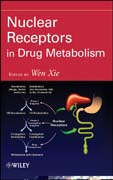
Providing an updated and expert overview of nuclear hormone receptors in drugmetabolism and drug development, this book equips drug development scientistswith an interdisciplinary understanding of these receptors and how to regulate them. This aids in pharmaceutical research to target drugs and treat diseases like cancer, coronary heart disease, and diabetes. A single source for researchers, this book collects material otherwise scattered among journals, and adds background and applications data to make the chapters more comprehensive. INDICE: Chapter 1: Drug Metabolism: Significance and Challenges. 1.1. Introduction. 1.2. Phase I Drug Metabolizing Enzymes. 1.3. Phase II Drug Metabolizing Enzymes. 1.4. Drug Efflux Transporters. 1.5. Drug Uptake Transporters. 1.6. Challenges in Drug Metabolism. 1.7. Summary. 1.8. References. Chapter 2. Establishing Orphan Nuclear Receptors PXR and CAR as Xenobiotic Receptors. 2.1. Introduction. 2.2. Nuclear receptor and orphan nuclear receptor superfamily. 2.3. Orphan nuclear receptors as xenobiotic receptors and their implications in Phase I enzyme regulation. 2.4. Perspectives. 2.5. References. Chapter 3: Nuclear Receptor-Mediated Regulation of Phase II Conjugating Enzymes. 3.1. Introduction. 3.2. Phase II drug metabolizing enzymes. 3.3. The xenosensors CAR and PXR: 2 masters regulators of phase II metabolism. 3.4. AhR and Nrf2, two important regulators of phase II enzymes. 3.5. PPARs and phase II XMEs regulation. 3.6. FXR/LXR and phase II XMEs regulation. 3.7. HNF and phase II XMEs regulation. 3.8. Regulation of phase II conjugating enzymes by steroid receptors. 3.9. Concluding remarks and perspectives. 3.10. References. Chapter 4: Nuclear Receptor-Mediated Regulation of Drug Transporters. 4.1. Introduction. 4.2. Drug transporters. 4.3. Induction of drug transporters by activation of PXR and CAR. 4.4. Induction of drug transporters by activation of PPARa. 4.5. Molecular mechanism of PXR- and CAR-dependent drug transporter regulation. 4.6. Induction of drug transporter expression and drug disposition. 4.7. Conclusions and future perspectives. 4.8. References. Chapter 5: Structure and Function of PXR and CAR. 5.1. Introduction. 5.2. Structure and Function of PXR. 5.3. Structure andFunction of CAR. 5.4. Concluding Remarks. 5.5. References. Chapter 6: Xenobiotic Receptor Co-Factors and Co-Regulators. 6.1. Regulation of PXR and CAR nuclear translocation. 6.2. Nuclear receptor coregulators and epigenetic regulation of gene transcription. 6.3. PXR and CAR crosstalk with other nuclear receptors and transcription factors. 6.4. PXR and CAR regulation of lipid and glucosehomeostasis. 6.5. Conclusion. 6.6. References. Chapter 7: Animal Models of Xenobiotic Nuclear Receptors and Their Utility in Drug Development. 7.1. Introduction. 7.2. PXR and CAR loss-of-function (knockout) mouse models. 7.3. PXR andCAR gain-of-function (transgenic) mouse models. 7.4. Humanized mouse models. 7.5. Utility of xenobiotic mouse models in pharmaceutical development. 7.6. Closing remarks. 7.7. References. Chapter 8: Nuclear Receptors and Drug-Drug Interactions of Prescription Drugs and Herbal Medicines. 8.1. Introduction. 8.2. Prescription drugs/drug classes commonly involved in inductive interactions. 8.3. Herbal medicines commonly involved in inductive interactions. 8.4. Pharmacology of induction. 8.5. Clinical aspects of induction-type drug interactions.8.6. Inhibition of nuclear receptors in clinical drug interactions. 8.7. Nuclear receptor-mediated drug side-effects. 8.8. Perspectives. 8.9. References. Chapter 9: Genetic Variants of Xenobiotic Receptors and Their Implications in Drug Metabolism and Pharmacogenetics. 9.1. PXR-background. 9.2. PXR gene structure. 9.3. PXR alternative mRNAs. 9.4. Genetic variants in PXRs exons and theirfunctional consequences. 9.5. Genetic variants in introns 2-8 and the 3-UTR of PXR and their functional consequences. 9.6. Resequencing strategy for the PXR promoter and intron 1. 9.7. Genetic variation in the PXR promoter and 5-UTR and its functional relevance. 9.8. Genetic variation in PXRs intron 1 and its functional relevance. 9.9. In silico analysis for functional effect of SNPs inPXRs promoter, 5-UTR and intron 1. 9.10. SNPs in PXRs promoter and intron 1 affect putative hepatic nuclear factor (HNF) binding sites. 9.11. PXR SNPs havebeen associated with intestinal and hepatic inflammation and diseases. 9.12. PXR structural variation and other genomic features. 9.13. PXR summary. 9.14. CAR-background. 9.15. CAR gene structure. 9.16. CAR alternatively spliced RNAs. 9.17. CAR genetic variants (SNPs) and their functional consequences. 9.18. CAR summary. 9.19. References. Chapter 10: Beyond PXR and CAR, Xenobiotic Regulation by Other Nuclear Receptors. 10.1. Introduction. 10.2. Farnesoid X receptor (FXR). 10.3. Hepatocyte nuclear factor 4 alpha (HNF4a). 10.4. Vitamin D receptor (VDR). 10.5. Glucocorticoid receptor (GR). 10.6. Peroxisome proliferatoractivated receptors (PPAR). 10.7. Aryl hydrocarbon receptor (AhR). 10.8. Conclusions. 10.9. References. Chapter 11: The Emerging Role Of Retinoid-Related Orphan Receptor (ROR) And Its Crosstalk With LXR In The Regulation Of Drug Metabolizing Enzymes. 11.1. Introduction. 11.2. Orphan nuclear receptor RORa. 11.3. A potential role of RORs in xeno- and endobiotic gene regulation. 11.4. LXR and its regulation of drug metabolizing enzymes. 11.5. A functional cross-talkbetween RORa and LXR in the regulation of xeno- and endobiotic genes. 11.6. Closing remarks. 11.7. References.
- ISBN: 978-0-470-08679-7
- Editorial: John Wiley & Sons
- Encuadernacion: Cartoné
- Páginas: 352
- Fecha Publicación: 21/11/2008
- Nº Volúmenes: 1
- Idioma: Inglés
